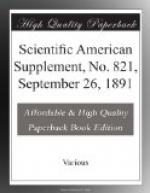Auxiliary Supply of Fresh Water.—Intimately associated with the feed is the means adopted for making up the losses of fresh water due to leakage of steam from safety valves, glands, joints, etc., and of water discharged from the air pumps. A few years ago this loss was regularly made up from the sea, with the result that the water in the boilers was gradually increased in density; whence followed deposit on the internal surfaces, and consequent loss of efficiency, and danger of accident through overheating the plates. With the higher pressures now adopted, the danger arising from overheating is much more serious, and the necessity is absolute of maintaining the heating surfaces free from deposit. This can be done only by filling the boiler with fresh water in the first instance, and maintaining it in that condition. To do this two methods are adopted, either separately or in conjunction. Either a reserve supply of fresh water is carried in tanks or the supplementary feed is distilled from sea water by special apparatus provided for the purpose. In the construction of the distilling or evaporating apparatus advantage has been taken of two important physical facts, namely, that, if water be heated to a temperature higher than that corresponding with the pressure on its surface, evaporation will take place; and that the passage of heat from steam at one side of a plate to water at the other is very rapid. In practice the distillation is effected by passing steam, say from the first receiver, through a nest of tubes inside a still or evaporator, of which the steam space is connected either with the second receiver or with the condenser. The temperature of the steam inside the tubes being higher than that of the steam either in the second receiver or in the condenser, the result is that the water inside the still is evaporated, and passes with the rest of the steam into the condenser, where it is condensed, and serves to make up the loss. This plan localizes




